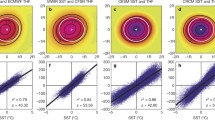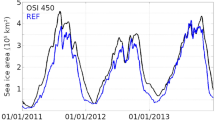Abstract
Coupled atmosphere–ocean general circulation models are known to have difficulties simulating the cold tongue in the equatorial Atlantic Ocean. Here a regional climate model coupled to an intermediate-level mixed layer ocean model with Ekman dynamics is developed and used to better understand the seasonal evolution of the equatorial Atlantic cold tongue and upwelling off western Africa. Parameterization improvements are made to an earlier version of the ocean model to account for the variations in temperature and shearing stress at the base of the mixed layer. 90-km resolution sensitivity tests demonstrate that the development of the equatorial Atlantic cold tongue in the boreal spring/summer is captured only if seasonal variations in the temperature at the base of the ocean mixed layer are included. The development of cold temperatures off the northwest African coast in the late boreal winter/spring is found to be primarily associated with the net radiation balance as shortwave warming of the mixed layer is relatively low while latent cooling is relatively high yielding a net cooling of mixed layer temperatures, consistent with other studies. The westward extension of the Atlantic cold tongue is primarily due to the horizontal advection of cool water from the South Atlantic African coast. This coastal cooling is associated with vertical diffusion and vertical entrainment, while the vertical entrainment has a secondary and more localized role over the equatorial Atlantic.














Similar content being viewed by others
References
Adamec D, O’Brien JJ (1978) The seasonal upwelling in the Gulf of Guinea due to remote forcing. J Phys Oceanogr 8:1050–1060
Berry G, Thorncroft CD (2005) Case study of an intense African easterly wave. Mon Wea Rev 133:752–766
Breugem WP, Hazeleger W, Haarsma RJ (2006) Multimodel study of tropical Atlantic variability and change. Geophys Res Lett 33. doi:10.1029/2006GL027831
Bryan K, Lewis LJ (1979) A water mass model of the world ocean. J Geophys Res 84:2503–2517
Caniaux G, Giordani H, Redelsperger JL, Guichard F, Key E, Wade M (2011) Coupling between the Atlantic cold tongue and the West African monsoon in boreal spring and summer. J Geophys Res 116. doi:10.1029/2010JC006570
Carlson TN (1969) Some remarks on African disturbances and their progress over the tropical Atlantic. Mon Wea Rev 97:716–726
Chang C, Nigam S, Carton JA (2008) Origin of the springtime westerly bias in equatorial Atlantic surface winds in the community atmosphere model version 3 (CAM3) simulation. J Climate 21:4766–4778
Chang P, Philander SGH (1994) A coupled ocean-atmosphere instability of relevance to seasonal cycle. J Atmos Sci 51:3627–3648
Chen F, Dudhia J (2001) Coupling an advanced land-surface/hydrology model with the Penn State/NCAR MM5 modeling system. Part I: model description and implementation. Mon Wea Rev 129:569–585
Chen SH, Sun WY (2002) A one-dimensional time dependent cloud model. J Meteor Soc Jpn 80:99–118
Cook KH., Vizy EK (2012) Impact of climate change on mid-21st century growing seasons in Africa. Clim Dyn. doi:10.1007/s00382-012-1324-1
Davey MK, Huddleston M, Sperber K et al (2002) STOIC: a study of coupled model climatology and variability in tropical ocean regions. Clim Dyn 18:403–420
Druyan LM (1991) The sensitivity of sub-Saharan precipitation to Atlantic SST. Climatic Change 18:17–36
Druyan LM, Koster RD (1989) Sources of Sahel precipitation for simulated drought and rainy seasons. J Climate 2:1438–1446
Dudhia J (1989) Numerical study of convection observed during the winter monsoon experiment using a mesoscale two-dimensional model. J Atmos Sci 46:3077–3107
Fedoseev A (1970) Geostrophic circulation of surface waters on the shelf of north-west Africa. Rapp P-V Reun Cons Int Explor Mer 159:32–37
Folland CK, Owen JA, Ward MN, Coleman AW (1991) Prediction of seasonal rainfall in the Sahel region of Africa using empirical and dynamical methods. J Forecasting 10:21–56
Folland CK, Palmer TN, Parker DE (1986) Sahel rainfall and worldwide sea temperatures. Nature 320:602–607
Foltz GR, Grodsky SA, Carton JA (2003) Seasonal mixed layer heat budget of the tropical Atlantic Ocean. J Geophys Res 108:3146. doi:10.1029/2002JC001584
Fu R, Dickinson RE, Chen MX, Wang H (2001) How do tropical sea surface temperatures influence the seasonal distribution of precipitation in the equatorial Amazon. J Climate 14:4003–4026
Grell GA, Dudhia J, Stauffer DR (1994) A description of the fifth-generation Penn State/NCAR mesoscale model (MM5). NCAR technical Note NCAR/TN-398 + STR, 122 pp
Grodsky SA, Carton JA, Nigam S (2003) Near surface westerly wind jet in the Atlantic ITCZ. Geophys Res Lett. doi:10.1029/2003GL017867
Hagen E (2000) Northwest African upwelling scenario. Oceanological Acta 24:S113–S128
Hagos SM, Cook KH (2009) Development of a coupled regional model and its application to the study of interactions between the West African monsoon and the eastern tropical Atlantic Ocean. J Climate 22:2591–2604
Halpern D (1980) Variability of near-surface currents in the Atlantic north equatorial countercurrent during GATE. J Phys Oceanogr 10:1213–1220
Hastenrath S, Heller L (1977) Some aspects of circulation and climate over the eastern equatorial Atlantic. Mon Wea Rev 106:1280–1287
Hastenrath S, Lamb PJ (1978) On the dynamics and climatology of surface flow over the equatorial oceans. Tellus 30:436–448
Hazeleger W, Haarsma RJ (2005) Sensitivity of tropical Atlantic climate to mixing in a coupled ocean-atmosphere model. Clim Dyn 25:387–399
Hong SY, Noh Y, Dudhia J (2006) A new vertical diffusion package with an explicit treatment of entrainment processes. Mon Wea Rev 134:2318–2341
Huang B, Hu ZZ, Jha B (2007) Evolution of model systematic errors in the tropical Atlantic Basin from coupled climate hindcasts. Clim Dyn 28:661–682
Janicot S (1992) Spatiotemporal variability of West African rainfall. Part II: associated surface and airmass characteristics. J Climate 5:499–511
Jochum M, Murtugudde R, Ferrari R, Malanotte-Rizzoli P (2005) The impact of horizontal resolution on the tropical heat budget in an Atlantic Ocean model. J Climate 18:841–851
Kain JS (2004) The Kain-Fritsch convective parameterization: an update. J Appl Meteor 43:170–181
Kanamitsu M, Ebisuzaki W, Woollen J, Yang SK, Hnilo JJ, Fiorino M, Potter GL (2002) NCEP-DOE AMIP-II Reanalysis (R2). Bull Amer Meteorol Soc 83:1631–1643
Kara AB, Rochford PA, Hurlburt HE (2003) Mixed layer depth variability over the global ocean. J Geophys Res 108. doi:10.1029/2000JC000736
Kunze E, Toole JM (1997) Tidally driven vorticity, diurnal shear, and turbulence atop Fieberling Seamount. J Phys Oceanogr 27:2663–2693
Lamb PJ (1978) Large-scale tropical Atlantic surface circulation patterns associated with sub-Saharan weather anomalies. Tellus 30:240–251
Lee SK, Csanady GT (1999) Warm water formation and escape in the upper tropical Atlantic Ocean 1. A literature review. J Geophys Res 104:29561–29571
Metcalf WG, Stalcup MC (1967) Origin of the Atlantic equatorial undercurrent. J Geophys Res 72:4959–4975
Mitchell TP, Wallace JM (1992) The annual cycle in equatorial convection and sea surface temperature. J Climate 5:1140–1156
Mittelstaedt E (1991) The ocean boundary along the northwest African coast: circulation and oceanographic properties at the sea surface. Prog Oceanogr 26:307–355
Mlawer EJ, Taubman SJ, Brown PD, Iacono MJ, Clough CA (1997) Radiative transfer for inhomogeneous atmosphere: RRTM, a validated correlated-k model for the longwave. J Geophys Res 102(D14):16663–16682
Munk WH (1966) Abyssal recipes. Deep-Sea Res 13:707–730
Navarra A (1999) Beyond El Niño decadal and interdecadal climate variability. Springer, New York
Okumura Y, Xie SP (2004) Interaction of the Atlantic equatorial cold tongue and African monsoon. J Climate 17:3589–3602
Pacanowski RC, Philander SGH (1981) Parameterization of vertical mixing in numerical models of tropical oceans. J Phys Oceanogr 11:1443–1451
Patricola CM, Cook KH (2010) Northern African climate at the end of the 21st century: integrated application of regional and global climate models. Clim Dyn 35:193–212
Patricola CM, Cook KH (2011) Sub-Saharan Northern African climate at the end of the twenty-first century: forcing factors and climate change processes. Climate Dyn 37:1165–1188
Patricola CM, Li M, Xu Z, Chang P, Saravanan R, Hsieh JS (2012) An investigation of tropical Atlantic bias in a high resolution coupled regional climate model. Clim Dyn. doi:10.1007/s00382-012-1320-5
Philander SGH, Pacanowski RC (1981) The oceanic response to cross-equatorial winds (with application to coastal upwelling in low latitudes). Tellus 33:201–210
Polzin KL, Toole JM, Ledwell JR, Schmitt RW (1997) Spatial variability of turbulent mixing in the abyssal ocean. Science 276:93–96
Pu B, Cook KH (2010) Dynamics of the West African westerly jet. J Climate 23:6263–6276
Pu P, Cook KH (2012) Role of the West African westerly jet in Sahel rainfall variations. J Climate 25:2880–2896
Redelsberger JL, Thorncroft CD, Diedhiou A, Lebel T, Parker D, Polcher J (2006) African monsoon multidisciplinary analysis: an international research project and field campaign. Bull Am Met Soc 87:1739–1746
Reynolds RW, Smith TM (1995) A high-resolution global sea surface temperature climatology. J Climate 8:1571–1583
Richter I, Xie SP (2008) On the origin of equatorial Atlantic biases in coupled general circulation models. Clim Dyn 31:587–598
Rowell DP, Folland CK, Maskell K, Ward MN (1995) Variability of summer rainfall over tropical North Africa (1906–92): observations and modeling. Quart J R Meteor Soc 121:669–704
Seo H, Jochum M, Murtugudde R, Miller AJ (2006) Effect of ocean mesoscale variability on the mean state of tropical Atlantic climate. Geophys Res Lett 33. doi:10.1029/2005GL025651
Servain J, Busalacchi AJ, McPhaden MJ, Moura AD, Reverdin G, Vianna M, Zebiak SE (1998) A pilot research moored array in the Tropical Atlantic (PIRATA). Bull Am Meteorol Soc 79:2019–2031
Skamarock WC, Klemp JB, Dudhia J, Gill DO, Barker DM, Wang W, Powers JG (2005) A description of the advanced research WRF version 2. NCAR/TN-408 + STR, 88 pp (available from NCAR Information Services, P.O. Box 3000, Boulder, CO 80307)
Sterl A, Hazeleger W (2003) Coupled variability and air-sea interaction in the South Atlantic Ocean. Clim Dyn 21:559–571
Tanimoto Y, Xie SP (2002) Inter-hemispheric decadal variations in SST, surface wind, heat flux and cloud cover over the Atlantic Ocean. J Meteorol Soc Jpn 80:1199–1219
Vizy EK, Cook KH (2001) Mechanisms by which Gulf of Guinea and eastern North Atlantic sea surface temperature anomalies can influence African rainfall. J Climate 14:795–821
Vizy EK, Cook KH (2002) Development and application of a mesoscale climate model for the tropics: Influence of sea surface temperature anomalies on the West African monsoon. J Geophys Res 107. doi:10.1029/2001JD000686
Vizy EK, Cook KH (2012) Mid-21st century changes in extreme events over northern and tropical Africa. J Climate. doi:10.1175/JCLI-D-11-00693.1
Voituriez B (1981) The equatorial upwelling in the eastern Atlantic ocean, Report of final meeting SCOR WG 47, pp 229–247, Nova Southeast. University Press, Fort Lauderdale
Wahl X, Chang P, Jackson CS, Ji L, Li M (2011) Plausible effect of climate model bias on abrupt climate change simulations in Atlantic sector. Deep Sea Res 58:1904–1913
Ward NM (1998) Diagnosis and short-lead time prediction of summer rainfall in tropical North Africa at interannual and multidecadal timescales. J Climate 11:3167–3191
Weingartner TJ, Weisberg RH (1991) On the annual cycle of equatorial upwelling in the central Atlantic Ocean. J Phys Oceanogr 21:68–82
Wen CH, Chang P, Saravanan R (2011) Effect of Atlantic meridional overturning circulation on tropical Atlantic variability: a regional coupled model study. J Climate 24:3323–3343
Zipser EJ, Gautier C (1978) Mesoscale events within a GATE tropical depression. Mon Wea Rev 106:789–805
Acknowledgments
Support from the U.S. Department of Energy Office of Science (award DE-FG02-08ER64610) is gratefully acknowledged. The authors would also like to acknowledge Dr. Samson Hagos for his useful comments that aided in improving the coupled model. The Texas Advanced Computing Center (TACC) at the University of Texas at Austin provided the high performance computing and database resources for the simulations. Microwave OI SST data are produced by Remote Sensing Systems and sponsored by National Oceanographic Partnership Program (NOPP), the NASA Earth Science Physical Oceanography Program, and the NASA MEaSUREs DISCOVER Project. Data are available at www.remss.com.
Author information
Authors and Affiliations
Corresponding author
Rights and permissions
About this article
Cite this article
Vizy, E.K., Cook, K.H. Capturing the Atlantic cold tongue and coastal upwelling in an intermediate-level ocean model coupled to a regional climate model. Clim Dyn 42, 345–366 (2014). https://doi.org/10.1007/s00382-013-1807-8
Received:
Accepted:
Published:
Issue Date:
DOI: https://doi.org/10.1007/s00382-013-1807-8




